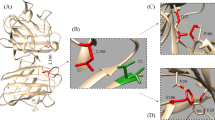Abstract
Mutations in human laforin lead to an autosomal neurodegenerative disorder Lafora disease. In N-terminal carbohydrate binding domain of laforin, two mutations W32G and K87A are reported as highly disease causing laforin mutants. Experimental studies reported that mutations are responsible for the abolishment of glycogen binding which is a critical function of laforin. Our current computational study focused on the role of conformational changes in human laforin structure due to existing single mutation W32G and prepared double mutation W32G/K87A related to loss of glycogen binding. We performed 10 ns molecular dynamics (MD) simulation studies in the Gromacs package for both mutations and analyzed the trajectories. From the results, the global properties like root mean square deviation, root mean square fluctuation, radius of gyration, solvent accessible surface area and hydrogen bonds showed structural changes in atomic level observed in W32G and W32G/K87A laforin mutants. The conformational change induced by mutants influenced the loss of the overall stability of the native laforin. Moreover, the change in overall motion of protein was analyzed by principal component analysis and results showed protein clusters expanded more than native and also change in direction in case of double mutant in conformational space. Overall, our report provides theoretical information on loss of structure–function relationship due to flexible nature of laforin mutants. In conclusion, comparative MD simulation studies support the experimental data on W32G and W32G/K87A related to the lafora disease mechanism on glycogen binding.







Similar content being viewed by others
Abbreviations
- MD:
-
Molecular dynamics
- RMSD:
-
Root mean square deviation
- RMSF:
-
Root means square fluctuation
- Rg:
-
Radius of gyration
- SASA:
-
Solvent accessible surface area
- PCA:
-
Principal component analysis
References
Minassian BA, Lee JR, Herbrick JA, Huizenga J, Soder S, Mungall AJ, Dunham I, Gardner R, Fong CY, Carpenter S, Jardim L, Satishchandra P, Andermann E, Snead OC III, Lopes-Cendes I, Tsui LC, Delgado-Escueta AV, Rouleau GA, Scherer SW (1998) Mutations in a gene encoding a novel protein tyrosine phosphatase cause progressive myoclonus epilepsy. Nat Genet 20:171–174
Tagliabracci VS, Julie T, Wei W, Jean-Marie G, Xiaochu Z, Skurat AV, Delgado-Escueta AV, Minassian BA, DePaoli-Roach AA, Roach PJ (2007) Laforin is a glycogen phosphatase, deficiency of which leads to elevated phosphorylation of glycogen in vivo. PNAS 104(49):19262–19266
Minassian BA (2002) Progressive myoclonus epilepsy with polyglucosan bodies: lafora disease. Adv Neurol 89:199–210
Sakai M, Austin J, Witmer F, Trueb L (1970) Studies in myoclonus epilepsy (Lafora body form). II. Polyglucosans in the systemic deposits of myoclonus epilepsy and in corpora amylacea. Neurology 20:160–176
Baykal B (2008) Progresif miyoklonik hastal›klar- Lafora hastal. Epilepsi 14:17–51
Lafora GR (1911) Uber des Vorkommen amyloider KJrperchen im innern der Ganglienzellen. Pathol Anat 205:295–303
Striano P, Zara F, Turnbull J, Girard JM, Ackerley CA, Cervasio M, Rosa GD, Basso-De Caro MLD, Striano S, Minassian BA (2008) Typical progression of myoclonic epilepsy of the Lafora type: a case report. Nat Clin Pract Neurol 4:106–111
Gambetti P, Di Mauro S, Hirt L, Blume RP (1971) Myoclonic epilepsy with Lafora bodies. Arch Neurol 25:483–493
Gentry MS, Dixon JE, Worby CA (2009) Lafora disease: insights into neurodegeneration from plant metabolism. Trends Biochem Sci 34:628–639
Ganesh S, Agarwala KL, Ueda K, Akagi T, Shoda K, Usui T, Hashikawa T, Osada H, Delgado-Escueta AV, Yamakawa K (2000) Laforin, defective in the progressive myoclonus epilepsy of Lafora type, is a dual-specificity phosphatase associated with polyribosomes. Hum Mol Genet 9:2251–2261
Gentry MS, Dowen RH, Worby CA, Mattoo S, Ecker JR, Dixon JE (2007) The phosphatase laforin crosses evolutionary boundaries and links carbohydrate metabolism to neuronal disease. J Cell Biol 178(3):477–488
Ianzano L, Zhang J, Chan EM, Zhao XC, Lohi H, Scherer SW, Minassian BA (2005) Lafora progressive myoclonus epilepsy mutation database-EPM2A and NHLRC1 (EPM2B) genes. Hum Mutat 26(4):397
Gomez-Garre P, Sanz Y, Rodrıguez de Cordoba S, Serratosa JM (2000) Mutational spectrum of the EPM2A gene in progressive myoclonus epilepsy of Lafora: high degree of allelic heterogeneity and prevalence of deletions. Eur J Hum Genet 8:946–954
Wang J, Stuckey JA, Wishart MJ, Dixon JE (2002) A unique carbohydrate binding domain targets the lafora disease phosphatase to glycogen. J Biol Chem 27:2377–2380
Guex N, Peitsch MC (1997) SWISS-MODEL and the Swiss-PdbViewer: an environment for comparative protein modeling. Electrophoresis 18:2714–2723
Laskowski RA, MacArthur MW, Moss DS, Thornton JM (1993) PROCHECK—a program to check the stereochemical quality of protein structures. J Appl Crystallogr 26:283–291
Berendsen HJC, van der Spoel D, van Drunen R (1995) GROMACS: a message-passing parallel molecular dynamics implementation. Comput Phys Commun 91:43–56
Berendsen HJC, Grigera JR, Straatsma TP (1997) The missing term in effective pair potentials. J Phys Chem 91:6269–6271
Cheatham TEIII, Miller JL, Fox T, Darden TA, Kollman PA (1995) Molecular dynamics simulations on solvated biomolecular systems: the particle mesh Ewald method leads to stable trajectories of DNA, RNA, and proteins. J Am Chem Soc 14:4193–4194
Hess B, Bekker H, Berendsen HJC, Fraaije JGEM (1996) LINCS: a linear constraint solver for molecular simulations. J Comput Chem 18:1463–1472
Miyamoto S, Kollman PA (1992) SETTLE an analytical version of the SHAKE and RATTLE algorithms for rigid water models. J Comput Chem 13:952–962
Berendsen HJC, Postma JPM, van Gunsteren WF, Dinola A, Haak JR (1984) Molecular dynamics with coupling to an external bath. J Chem Phys 8:3684–3690
Amadei A, Linssen AB, Berendsen HJ (1993) Essential dynamics of proteins. Proteins 17:412–425
Author information
Authors and Affiliations
Corresponding author
Rights and permissions
About this article
Cite this article
Srikumar, P.S., Rohini, K. & Rajesh, P.K. Molecular Dynamics Simulations and Principal Component Analysis on Human Laforin Mutation W32G and W32G/K87A. Protein J 33, 289–295 (2014). https://doi.org/10.1007/s10930-014-9561-2
Published:
Issue Date:
DOI: https://doi.org/10.1007/s10930-014-9561-2




